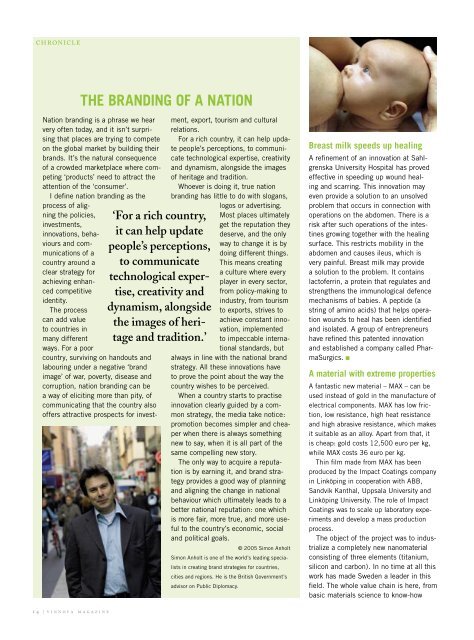Free download - Vinnova
Free download - Vinnova
Free download - Vinnova
Create successful ePaper yourself
Turn your PDF publications into a flip-book with our unique Google optimized e-Paper software.
CHRONICLE<br />
THE BRANDING OF A NATION<br />
‘For a rich country,<br />
it can help update<br />
people’s perceptions,<br />
to communicate<br />
technological expertise,<br />
creativity and<br />
dynamism, alongside<br />
the images of heritage<br />
and tradition.’<br />
Nation branding is a phrase we hear<br />
very often today, and it isn’t surprising<br />
that places are trying to compete<br />
on the global market by building their<br />
brands. It’s the natural consequence<br />
of a crowded marketplace where competing<br />
‘products’ need to attract the<br />
attention of the ‘consumer’.<br />
I define nation branding as the<br />
process of aligning<br />
the policies,<br />
investments,<br />
innovations, behaviours<br />
and communications<br />
of a<br />
country around a<br />
clear strategy for<br />
achieving enhanced<br />
competitive<br />
identity.<br />
The process<br />
can add value<br />
to countries in<br />
many different<br />
ways. For a poor<br />
country, surviving on handouts and<br />
labouring under a negative ‘brand<br />
image’ of war, poverty, disease and<br />
corruption, nation branding can be<br />
a way of eliciting more than pity, of<br />
communicating that the country also<br />
offers attractive prospects for investment,<br />
export, tourism and cultural<br />
relations.<br />
For a rich country, it can help update<br />
people’s perceptions, to communicate<br />
technological expertise, creativity<br />
and dynamism, alongside the images<br />
of heritage and tradition.<br />
Whoever is doing it, true nation<br />
branding has little to do with slogans,<br />
logos or advertising.<br />
Most places ultimately<br />
get the reputation they<br />
deserve, and the only<br />
way to change it is by<br />
doing different things.<br />
This means creating<br />
a culture where every<br />
player in every sector,<br />
from policy-making to<br />
industry, from tourism<br />
to exports, strives to<br />
achieve constant innovation,<br />
implemented<br />
to impeccable international<br />
standards, but<br />
always in line with the national brand<br />
strategy. All these innovations have<br />
to prove the point about the way the<br />
country wishes to be perceived.<br />
When a country starts to practise<br />
innovation clearly guided by a common<br />
strategy, the media take notice:<br />
promotion becomes simpler and cheaper<br />
when there is always something<br />
new to say, when it is all part of the<br />
same compelling new story.<br />
The only way to acquire a reputation<br />
is by earning it, and brand strategy<br />
provides a good way of planning<br />
and aligning the change in national<br />
behaviour which ultimately leads to a<br />
better national reputation: one which<br />
is more fair, more true, and more useful<br />
to the country’s economic, social<br />
and political goals.<br />
© 2005 Simon Anholt<br />
Simon Anholt is one of the world’s leading specialists<br />
in creating brand strategies for countries,<br />
cities and regions. He is the British Government’s<br />
advisor on Public Diplomacy.<br />
Breast milk speeds up healing<br />
A refinement of an innovation at Sahlgrenska<br />
University Hospital has proved<br />
effective in speeding up wound healing<br />
and scarring. This innovation may<br />
even provide a solution to an unsolved<br />
problem that occurs in connection with<br />
operations on the abdomen. There is a<br />
risk after such operations of the intestines<br />
growing together with the healing<br />
surface. This restricts mobility in the<br />
abdomen and causes ileus, which is<br />
very painful. Breast milk may provide<br />
a solution to the problem. It contains<br />
lactoferrin, a protein that regulates and<br />
strengthens the immunological defence<br />
mechanisms of babies. A peptide (a<br />
string of amino acids) that helps operation<br />
wounds to heal has been identified<br />
and isolated. A group of entrepreneurs<br />
have refined this patented innovation<br />
and established a company called PharmaSurgics.<br />
A material with extreme properties<br />
A fantastic new material – MAX – can be<br />
used instead of gold in the manufacture of<br />
electrical components. MAX has low friction,<br />
low resistance, high heat resistance<br />
and high abrasive resistance, which makes<br />
it suitable as an alloy. Apart from that, it<br />
is cheap: gold costs 12,500 euro per kg,<br />
while MAX costs 36 euro per kg.<br />
Thin film made from MAX has been<br />
produced by the Impact Coatings company<br />
in Linköping in cooperation with ABB,<br />
Sandvik Kanthal, Uppsala University and<br />
Linköping University. The role of Impact<br />
Coatings was to scale up laboratory experiments<br />
and develop a mass production<br />
process.<br />
The object of the project was to industrialize<br />
a completely new nanomaterial<br />
consisting of three elements (titanium,<br />
silicon and carbon). In no time at all this<br />
work has made Sweden a leader in this<br />
field. The whole value chain is here, from<br />
basic materials science to know-how<br />
1 4 | V I N N O V A M A G A Z I N E

















